
Feature Article
COVID-19 and Food Safety
Recently, several local warehouse workers responsible for labelling prepackaged foods were confirmed to be infected with Coronavirus Disease 2019 (COVID-19). This arouses public concern as to whether touching objects (including food packaging) contaminated with the novel coronavirus would contract the disease. The virus is mainly transmitted through respiratory droplets, but it can also be transmitted through contact. In this issue, we will look into the matters related to COVID-19 in the food business and highlight the key hygienic measures.
Can COVID-19 Be Transmitted by Food Packaging?
Recent research suggested that the novel coronavirus can survive on the surfaces of objects for a few hours to several days under controlled, experimental conditions. However, the virus cannot multiply in food or food packaging. The risk of acquiring the virus through food packaging appears to be very low in real-life situations. According to the World Health Organization (WHO), it is highly unlikely that people can contract COVID-19 from food or food packaging. To date, there is also no evidence of viruses that cause respiratory illnesses being transmitted via food or food packaging. Among the 1 000-odd cases of COVID-19 reported so far in Hong Kong, none was identified as potentially transmitted through food packaging.
Should Consumers Sanitise Food Packaging?
Contaminated hands play a significant role in facilitating indirect contact transmission by transferring infectious viruses from one surface to another and even into one’s body. Compared with food packaging, high-touch points such as door handles, handles of shopping trolleys and water taps pose a greater risk of infection. The more frequently they are touched by different people, the higher the risk of contamination. While some people may still opt to disinfect food packaging surfaces with common household disinfectants like alcohol-based wipes or sprays if needed, it is more important to wash hands thoroughly, especially before touching eyes, nose and mouth, after returning home from grocery shopping and after handling and storing purchased food products.
In addition to the health advice issued by the Centre for Health Protection, the public can also make reference to the recommendations on enhancing hygiene as illustrated in Figure 1 to prevent the spread of COVID-19.
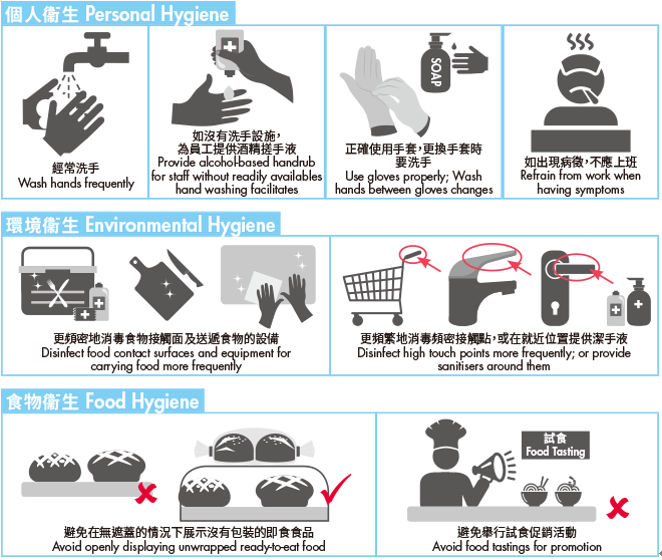
Figure 1: Hygiene enhancement measures
Eat Safe: Home-packed Meals, Takeaways and Delivered Foods
During the COVID-19 pandemic, many people prefer packing their own meals or ordering takeaways and delivered foods from restaurants. Regardless of where foods are prepared, it is important to handle foods properly to maintain food safety. The following paragraphs will discuss the major food safety risks of home-packed meals and give recommendations on how to reduce the risk of foodborne diseases.
Food Safety Risks of Packed Meals Prepared at Home
Home-packed meals are usually not consumed instantly after preparation. They will be either stored or carried for some time before being served, during which foods may be contaminated. If these foods are not kept properly, pathogenic bacteria present in the foods may grow to an unsafe level or produce heat-stable toxins, subsequently causing illnesses.
People usually prepare lunchboxes with food ingredients that have been previously cooked and cooled. Excessive time for cooling may favour the introduction and growth of microorganisms in the foods. While reheating can effectively kill microorganisms, it cannot eliminate the heat-stable toxins produced by pathogenic bacteria, which can lead to food poisoning.

Figure 2: Procedures for handling home-packed meals
Key Points to Note
- Home-packed meals are not intended for immediate consumption after preparation. If these foods are not handled properly, the risk of foodborne diseases will increase.
- If cooked food is to be cooled for later consumption, cool it rapidly and maintain a cold temperature during storage. The food should be thoroughly reheated before consumption.
- Keep food out of the temperature danger zone (i.e. 4°C to 60°C) to limit the growth of microorganisms. As a rule of thumb, in the absence of temperature control, prepared foods left at room temperature for not more than two hours can be refrigerated for later use. Otherwise, they should be consumed within four hours. Foods left at room temperature for more than four hours must be discarded.
Advice to Public
- When preparing a lunchbox for the next day, put in the necessary amount of freshly cooked food ingredients and cool them rapidly. Maintain the cold chain (e.g. food storage in the refrigerator and conveyance of food in an insulated bag with ice packs) as far as practicable.
- Consume takeaways and delivered foods as soon as possible.
- Dirty hands can spread germs and contaminate food during food preparation. Always keep your hands clean and maintain good personal hygiene.
Readers' Corner
Home Cooking in the Time of Pandemic
The Government has called on the public to practise social distancing to limit the spread of COVID-19. In fact, people are more used to cooking at home than dining out these days. This article highlights the points to note in home cooking from the perspective of food hygiene. We should pay attention to these points to ensure food safety, especially in the time of pandemic.
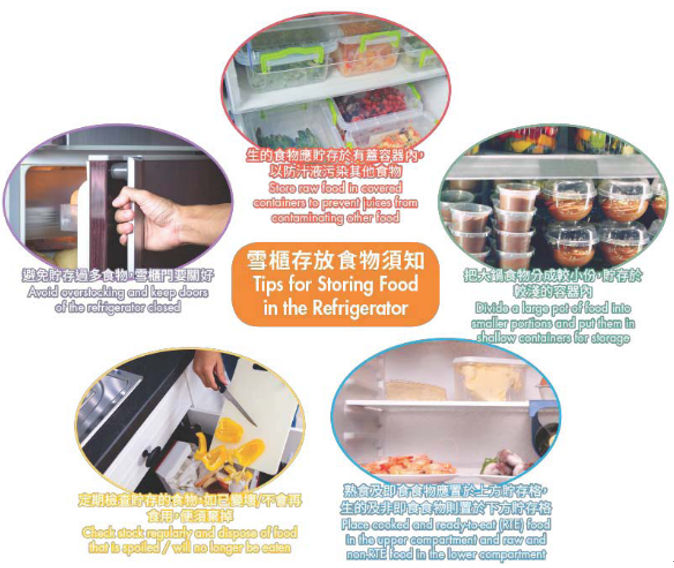
Figure 3: Tips for storing food in the refrigerator
Plan Ahead When Stocking up on Food
Some consumers may buy more food to meet the need for days. However, food can be spoiled and wasted if not kept properly. It is often wise to estimate and buy the quantity that is really needed to avoid overstocking. We can maintain a list of favourite dishes (and their ingredients) of household members and store the food items properly after purchase, such as placing them in the refrigerator (at 4°C or below) or freezer (at -18°C or below). The proper ways of storing food in the refrigerator are shown in Figure 3. For food not requiring refrigeration, storage in a cool and dry place can help reduce bacterial growth.
Follow Safe Food Handling Practices
Although the novel coronavirus is unlikely to be transmitted to humans via food, the general rules of hygiene for preparing food should be observed. Wash hands before handling food or when they are contaminated by respiratory secretions (e.g. after coughing or sneezing). Clean hands with liquid soap and water if they are visibly dirty or soiled with body fluids. Other food safety measures such as handling raw and cooked food separately and cooking food thoroughly should also be maintained.
Proper Handling of Leftovers
There will be leftovers when people cook more than they can eat. For the sake of convenience, some families may also prepare a large amount of food in one sitting for later consumption. However, unfinished food is susceptible to spoilage and contamination if not cooled and stored properly.
To prevent bacterial growth, food should be cooled rapidly to a temperature suitable for refrigeration. Food can be cooled down quickly by slicing larger pieces into smaller ones. Leftovers should be covered, wrapped in airtight packaging or sealed in storage containers. These practices help keep bacteria out, avoid cross-contamination, retain moisture in food and prevent leftovers from picking up odours from other food items in the refrigerator. Most importantly, food should be refrigerated within two hours after preparation and discarded if left at room temperature for more than four hours.
One More Step Forward - Reduce Dietary Intake of Sodium and Sugar
With more time spent at home, it is a good opportunity for us to build healthier eating habits by cooking our own meals. Noting that too much sodium and sugar in food can increase the risk of chronic diseases, we can control the amount of salt and sugar added to our dishes through home cooking. By reading the nutrition labels on prepackaged foods, we can also find out the amount of sodium and sugar we would absorb through consumption of the products.
Food safety is a prerequisite for a healthy diet. In the time of pandemic, it is of utmost importance to ensure food safety. Taking a renewed interest in home cooking, the public should always observe the "Five Keys to Food Safety" to prevent foodborne diseases.
Spot Check
Restaurant Scene
1. Eggs Cooked Around the Barbecue Pan
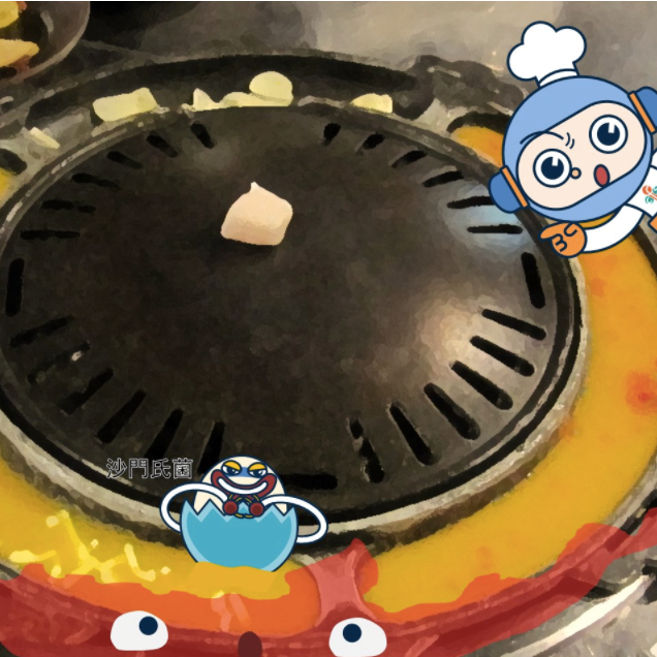
In April 2020, some people suffered from food poisoning and developed symptoms of abdominal pain, vomiting, diarrhoea and fever after consuming eggs cooked around the barbecue pan at a Korean restaurant. The eggs might have been contaminated with Salmonella. Initial investigation found that the possible causes of food poisoning include improper storage temperature of food (egg mixture), keeping food (egg mixture) in room temperature for a prolonged period and inadequate cooking of eggs.
Salmonella can contaminate eggs via the infected reproductive organs of hens during egg formation, or through eggshell penetration from contaminated faeces of hens during or after they lay eggs. For these reasons, Salmonella can be found in raw or undercooked egg dishes and it is impossible to identify a contaminated egg from its appearance. Moreover, improper storage temperature (e.g. room temperature) also facilitates the growth of Salmonella in undercooked eggs. Thorough cooking is an important step to kill the bacteria in food and failing to do so may cause food poisoning.
Advice to the Public
- Eggs should be thoroughly cooked until the yolk and white are firm before consumption.
- When consuming eggs cooked around the barbecue pan, make sure the raw egg mixture does not get onto other foods to avoid cross-contamination.
- Choose pasteurised eggs for making soft-scrambled egg dishes.
- High-risk groups including pregnant women, young children, the elderly and immunocompromised persons are advised not to consume raw eggs or undercooked egg dishes.
2. Enoki Mushrooms and Listeria Monocytogenes
In March 2020, the Centre for Food Safety (CFS) noted a batch of Enoki mushrooms from Korea, purportedly contaminated by Listeria monocytogenes (LM), had caused illnesses and death cases and was being recalled in the United States.
Consuming LM contaminated food may result in a disease called listeriosis. Symptoms include abdominal pain, fever and headache. The susceptible populations including infants, the elderly and people with weakened immunity are more prone to the disease.
Pregnant women infected with listeriosis may just experience mild, flu like symptoms or even no symptoms. However, it should be noted that LM can pass to the foetus through the placenta, imposing a risk of miscarriage, stillbirth or premature birth. The newborn may also have low birth weight, septicaemia and meningitis.
LM can survive and multiply at temperatures as low as 0°C. It is more likely to be present in prolonged refrigerated food, such as cold-smoked salmon. However, LM can be destroyed under normal cooking temperatures.
Advice to the Public
- Cook food that is not intended to be eaten readily all the way through. Store raw and cooked food separately to avoid cross-contamination.
- Follow the cooking/ preparation instructions on the label of non-ready-to-eat prepackaged frozen vegetables.
Updates on CFS
Food Safety Day 2020
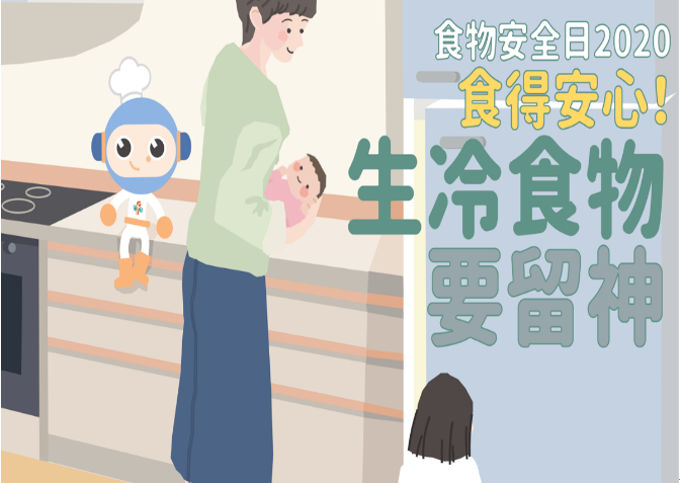
The Food Safety Day is an annual signature event of the CFS with a view to strengthening collaboration among the Government, the trade and the public. The theme for this year is "Eat Safe! Know Your High-risk Foods".
When "raw and cold food" is mentioned, it is usually sushi, sashimi or raw oysters that come to people's minds. Actually, this is a loose description of raw or undercooked foods, generally referred to as high-risk foods. You may not notice that some common food products may contain raw or undercooked ingredients, for examples, there are mango pudding made with raw eggs, smoked salmon (a raw food) sandwiches and congee prepared with undercooked beef. Through Food Safety Day 2020, the CFS will advise the public (especially the susceptible populations) to adopt a vigilant approach in handling and consuming high-risk foods in their daily diet. The CFS will also remind the trade what efforts can be made to enable consumers to make informed choices when purchasing high-risk foods.
Please stay tuned to the CFS website for updates on Food Safety Day 2020.
Briefing of Activities
Food Safety Talks and Activities for Schools
The CFS enhances students' understanding of the importance of food safety through a host of channels. Health Inspectors of the Communication Resource Unit (CRU) visit schools and give talks on food safety to share a wide range of food knowledge with students, thereby heightening their awareness of food safety and promoting healthy eating habits. On some occasions, there will be interactive activities such as colouring competitions and tasting sessions on salt/sugar content of food to arouse students' interest in the topics.
The CRU regularly sends letters to primary and secondary schools offering to conduct talks on various topics, including "Nutrition Labelling", "Food Poisoning", "Five Keys to Food Safety", "Natural Toxins in Food", "Veterinary Drug Residues in Food" and "Genetically Modified Food". Interested schools may reply and make an appointment. The CRU will proceed to arrange Health Inspectors to deliver a talk at the school and distribute leaflets and other publicity materials to the students.
Upcoming Activities
Communication Resource Unit Open to Visitors
The CRU of the CFS was relocated from 8/F, Fa Yuen Street Municipal Services Building, 123A Fa Yuen Street, Mong Kok, Kowloon to Room 401, 4/F, Food and Environmental Hygiene Department Nam Cheong Offices and Vehicle Depot, 87 Yen Chow Street West, Sham Shui Po, Kowloon on 22 July 2019.
Under the Risk Communication Section, the CRU maintains a rich collection of resource materials which facilitate consumers in making better food choices and the trade in supplying safe food. Located in the city centre, the CRU has set up an exhibition hall with public and trade corners and audiovisual facilities for visitors to gain direct access to food safety information of Hong Kong. For booking of visits, requests for resource materials, exhibition boards and audiovisual resources, or any other enquiries, please contact the CRU in person or by phone during office hours.
| CRU Address: | Room 401, 4/F, Food and Environmental Hygiene Department Nam Cheong Offices and Vehicle Depot, 87 Yen Chow Street West, Sham Shui Po, Kowloon |
| Enquiries: | 2381 6096 |
| Email: | rc@fehd.gov.hk |
| Office hours: |
Monday to Friday: 8:45 am to 1:00 pm |
Food Safety Q&A
Can COVID-19 Be Transmitted via Food?
Karly: Daddy, today at lunch break, Fanny, who sits next to me, was scared by Siu Yin. When she was eating, he told her COVID-19 can be transmitted by food. Fanny was so frightened that she did not eat anymore. Can COVID-19 be spread by food?
Daddy: Based on the present scientific findings, there is no evidence that humans can catch COVID-19 via food. The WHO and food safety assessment authorities around the world do not consider that people are likely to be infected by the novel coronavirus via food. However, the WHO advises that we should always observe personal, food and environmental hygiene to ensure food safety.
Karly: I get it now. Daddy, your explanation is so clear. I will let Fanny know tomorrow.
Daddy: Remember to remind your classmates to pay attention to food safety and wash their hands thoroughly before having meals. Actually I get the related information from a website. You can view it by clicking this link: https://www.cfs.gov.hk/english/whatsnew/files/Food_Safety_Advice_on_Prevention_of_COVID-19_and_FAQs_rev_20200228.pdf.
Karly: I see.
Truth Against Fallacy
Food Additives in Perspective
With the advent of the food processing technology, food additives are playing an important role in ensuring food safety and food quality. Most food products on supermarket shelves, in particular prepackaged foods, contain food additives. For instance, antioxidants can be found in vegetable oils to prevent them from turning rancid, and preservatives are added to bread to prevent mould and bacterial growth that would otherwise cause decay before the expiry date. In some breakfast cereals, sweeteners are used as a substitute for sugar to lower calories. Not only do food additives enhance the taste, texture and other qualities of food, they also improve the safety and extend the shelf life of food products so as to prevent foodborne diseases. Despite long-time and widespread application of food additives, there are concerns about their safety from time to time.
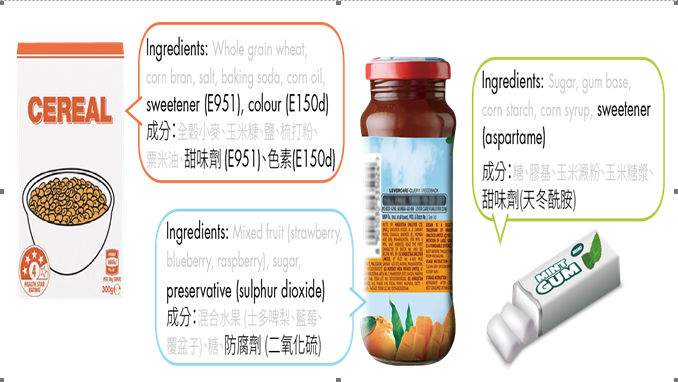
What Are Food Additives?
Food additives are substances, either natural or synthetic, added to food to help maintain or improve its safety, freshness, taste, texture, appearance, etc. Based on their technological functions, food additives are classified into different functional classes such as antioxidants, preservatives, colourants, sweeteners, acidity regulators, flavour enhancers, thickeners, emulsifiers, etc.
Are Food Additives Safe for Consumption?
Before a food additive is ascertained as safe for food use, it has to go through rigorous safety assessment. National and international food safety authorities, such as the Joint FAO / WHO Expert Committee on Food Additives (JECFA), collect and evaluate scientific data to assess the safety of food additives. If a food additive may not be safe for food use, it would not be approved for food application. Moreover, the JECFA will reassess an approved food additive based on new scientific data as and when necessary to ensure that it is safe for use.
Just as some people are allergic to certain foods (e.g. crustaceans and peanuts), individual persons may have allergic or adverse reactions to certain food additives. For example, people allergic to sulphur dioxide (a food additive) may experience breathing difficulties, headaches and nausea after consuming food containing this chemical compound.
How Are Food Additives Regulated in Hong Kong?
In Hong Kong, there are regulations which spell out the standards for specific food additives (e.g. antioxidants, preservatives, colourants and sweeteners) allowed in food. For food additives with no specified standards stipulated in the regulations, food traders should ensure that they are used in accordance with the principles of the Good Manufacturing Practice, that is, only the minimum amount of food additives should be applied to achieve the desired technological effect, and the food must be fit for human consumption. The CFS will conduct risk assessment on food additive levels of food samples if necessary.
How to Make an Informed Choice?
According to the Food and Drugs (Composition and Labelling) Regulations (Cap. 132W), if a food additive is used in a prepackaged food available for sale in Hong Kong, it must be listed by its functional class together with its specific name or identification number in the ingredient list on the food label. For example, if aspartame is added to a prepackaged food as a sweetener, it must be listed as sweetener (aspartame), sweetener (E951), or sweetener (951).
Advice to the Public
- Buy food from reputable sources.
- Read the labels of prepackaged foods carefully, with particular regard to the ingredient list, to check whether you are allergic to any food additive (if applicable) on the list.
- People allergic to certain food additives (e.g. sulphur dioxide) should be careful in selecting foods. Seek the advice of medical professionals if necessary.
- Avoid choosing foods with abnormal colour, smell and texture. Stop consumption if the food tastes weird.
- Report food irregularities to the authority for investigation and follow-up actions.
- Maintain a balanced and varied diet to avoid malnutrition due to the consumption of a limited range of food items.
Brain Gym
Multiple Choice Questions
- Which day in 2019 was designated by the United Nations as the World Food Safety Day?
- 1 July
- 6 October
- 7 June
- Which of the following practices will not lead to cross-contamination of food?
- Let juices from raw shellfish in the fridge drip onto the cake below.
- Process cooked siu-mei right after handling raw food.
- Put well covered cooked food on the upper compartment of the fridge.
- Which of the following is not a correct statement about food additives with no relevant standards specified in the laws of Hong Kong?
- Follow the Good Manufacturing Practice to apply only the minimum amount of food additives to achieve the desired technological effect.
- These food additives are exempted from inclusion in the ingredient list on the food label.
- Make reference to the safety evaluation results of the Joint FAO/WHO Expert Committee on Food Additives in applying these food additives.
Answers:
1. c 2. c 3. b
Enquiries and Subscription
Printed copies of the Food Safety Bulletin can be obtained from the Communication Resource Unit at Room 401, 4/F, Food and Environmental Hygiene Department Nam Cheong Offices and Vehicle Depot, 87 Yen Chow Street West, Sham Shui Po, Kowloon. For enquiries, please call 2381 6096.